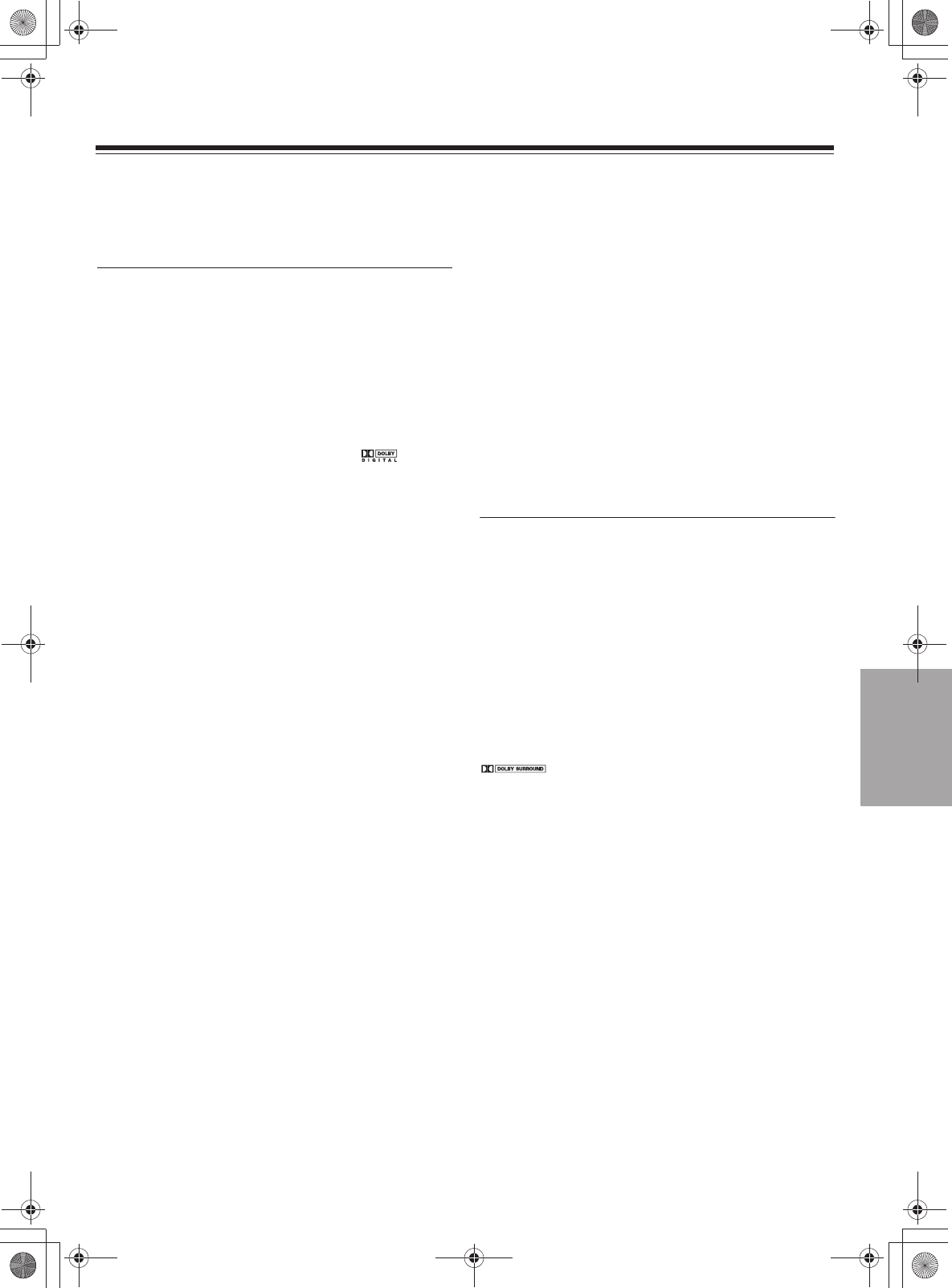
45
Enjoying the Sound Effects
The surround sound of the DVD receiver enables you to enjoy the presence of a movie theater or concert hall in your room.
Before using any sound effect, make sure the configurations for Adjusting Each Speaker’s Relative Volume Balance - Test Tone and Setting the
Distance From the Listening Position to Each Speaker have been set (see pages 33-34).
Following are the sound systems the DVD receiver can reproduce.
■ DOLBY DIGITAL Surround and DTS
(Digital Theater System) Surround
This 5.1 channel digital surround format enables you to individually
play five full-range (20Hz-20kHz) channels (front left and right,
center, and two surround channels) plus an LFE (Low Frequency
Effect) channel for low-range effect sound. It will create a realistic
sound like that heard in theaters and concert halls.
DOLBY DIGITAL Surround
Dolby Digital is compressed digital data with a maximum of 5.1-
channel surround sound.
This source signal comes from DVDs that have the mark and
therefore recorded for 5.1-channel output.
DTS Surround
DTS (Digital Theater System) is compressed digital data with a
maximum 5.1-channel surround output that allows for an extremely
high-quality sound.
Notes on DTS Surround
• If you play a DTS Surround encoded disc with the DVD receiver,
or a DTS encoded disc using a digitally connected player, you may
hear a noise for a short while until the DTS decoder of the DVD
receiver recognizes the DTS encoded signal and starts operating.
This is not a malfunction.
• If you play a DTS Surround source in fast reverse or fast forward,
pause, or skip a chapter or track, noise may be heard. This is not a
malfunction.
• Even when playback of the DTS Surround source stops and the
DTS signal transmission ends, the DVD receiver remains in DTS
mode and the DTS indicator remains lit. This is to prevent noise
when you pause, fast forward, fast reverse, or skip a chapter or
track of the playback source. Therefore, if the source switches
from the DTS signal to a PCM (2 channel digital stereo) signal
suddenly, the PCM signal may not be played. In such a case, stop
playback for about three seconds, then resume playback.
■ DOLBY PRO LOGIC II Surround
Opposed to Dolby Pro Logic, which had four channels (front, left,
center, and surround) recorded into two channels with matrix
processing and then played back in four channels, Dolby Pro LogicII
uses a feedback logic circuit to have 5.1-channel surround audio
(Dolby Surround, etc.) matrix-encoded into two channels and then
played back in its original 5.1-channel form.
Dolby Pro Logic II provides a Movie mode designed for playing
movies and a Music mode designed for listening to music.
In the Movie mode, the surround channels, which used to provide
monaural output over only a narrow frequency range, now provide
complete stereo output over the full frequency range.
The result is movie viewing with a realistic feel of movement.
The Music mode uses the surround channels to provide a natural
soundfield that cannot be provided with normal stereo output.
This mode can be used with VHS and DVD videos with the
mark and certain television programs.
The Music mode can be used with music compact discs and other
stereo sources.
EN00_L-MS30.book Page 45 Tuesday, September 2, 2003 4:19 PM


















